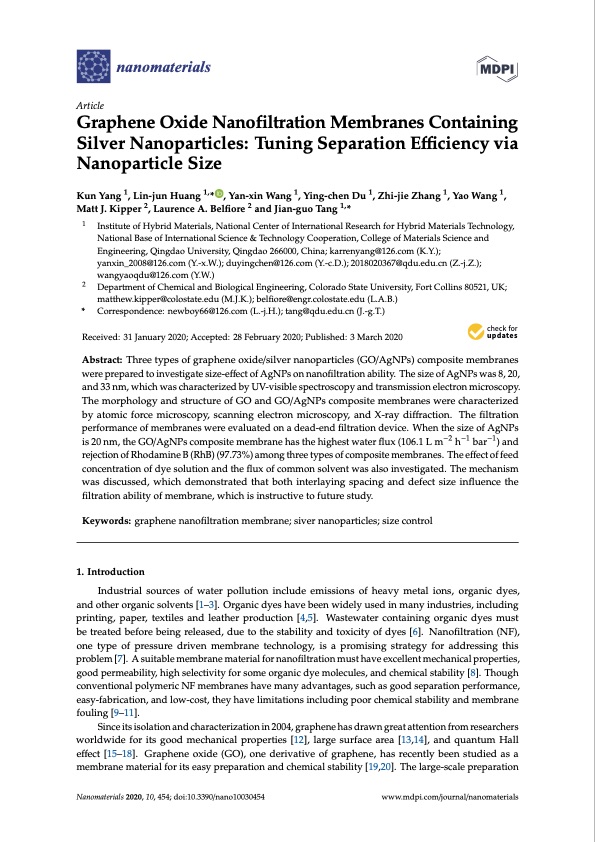
PDF Publication Title:
Text from PDF Page: 001
nanomaterials Article Graphene Oxide Nanofiltration Membranes Containing Silver Nanoparticles: Tuning Separation Efficiency via Nanoparticle Size Kun Yang 1, Lin-jun Huang 1,* , Yan-xin Wang 1, Ying-chen Du 1, Zhi-jie Zhang 1, Yao Wang 1, Matt J. Kipper 2, Laurence A. Belfiore 2 and Jian-guo Tang 1,* 1 2 matthew.kipper@colostate.edu (M.J.K.); belfiore@engr.colostate.edu (L.A.B.) Institute of Hybrid Materials, National Center of International Research for Hybrid Materials Technology, National Base of International Science & Technology Cooperation, College of Materials Science and Engineering, Qingdao University, Qingdao 266000, China; karrenyang@126.com (K.Y.); yanxin_2008@126.com (Y.-x.W.); duyingchen@126.com (Y.-c.D.); 2018020367@qdu.edu.cn (Z.-j.Z.); wangyaoqdu@126.com (Y.W.) Department of Chemical and Biological Engineering, Colorado State University, Fort Collins 80521, UK; * Correspondence: newboy66@126.com (L.-j.H.); tang@qdu.edu.cn (J.-g.T.) Received: 31 January 2020; Accepted: 28 February 2020; Published: 3 March 2020 Abstract: Three types of graphene oxide/silver nanoparticles (GO/AgNPs) composite membranes were prepared to investigate size-effect of AgNPs on nanofiltration ability. The size of AgNPs was 8, 20, and 33 nm, which was characterized by UV-visible spectroscopy and transmission electron microscopy. The morphology and structure of GO and GO/AgNPs composite membranes were characterized by atomic force microscopy, scanning electron microscopy, and X-ray diffraction. The filtration performance of membranes were evaluated on a dead-end filtration device. When the size of AgNPs is 20 nm, the GO/AgNPs composite membrane has the highest water flux (106.1 L m−2 h−1 bar−1) and rejection of Rhodamine B (RhB) (97.73%) among three types of composite membranes. The effect of feed concentration of dye solution and the flux of common solvent was also investigated. The mechanism was discussed, which demonstrated that both interlaying spacing and defect size influence the filtration ability of membrane, which is instructive to future study. Keywords: graphene nanofiltration membrane; siver nanoparticles; size control 1. Introduction Industrial sources of water pollution include emissions of heavy metal ions, organic dyes, and other organic solvents [1–3]. Organic dyes have been widely used in many industries, including printing, paper, textiles and leather production [4,5]. Wastewater containing organic dyes must be treated before being released, due to the stability and toxicity of dyes [6]. Nanofiltration (NF), one type of pressure driven membrane technology, is a promising strategy for addressing this problem [7]. A suitable membrane material for nanofiltration must have excellent mechanical properties, good permeability, high selectivity for some organic dye molecules, and chemical stability [8]. Though conventional polymeric NF membranes have many advantages, such as good separation performance, easy-fabrication, and low-cost, they have limitations including poor chemical stability and membrane fouling [9–11]. Since its isolation and characterization in 2004, graphene has drawn great attention from researchers worldwide for its good mechanical properties [12], large surface area [13,14], and quantum Hall effect [15–18]. Graphene oxide (GO), one derivative of graphene, has recently been studied as a membrane material for its easy preparation and chemical stability [19,20]. The large-scale preparation Nanomaterials 2020, 10, 454; doi:10.3390/nano10030454 www.mdpi.com/journal/nanomaterialsPDF Image | Graphene Oxide Nanofiltration Membranes Silver Nanoparticles

PDF Search Title:
Graphene Oxide Nanofiltration Membranes Silver NanoparticlesOriginal File Name Searched:
nanomaterials-10-00454-v2.pdfDIY PDF Search: Google It | Yahoo | Bing
Turbine and System Plans CAD CAM: Special for this month, any plans are $10,000 for complete Cad/Cam blueprints. License is for one build. Try before you buy a production license. More Info
Waste Heat Power Technology: Organic Rankine Cycle uses waste heat to make electricity, shaft horsepower and cooling. More Info
All Turbine and System Products: Infinity Turbine ORD systems, turbine generator sets, build plans and more to use your waste heat from 30C to 100C. More Info
CO2 Phase Change Demonstrator: CO2 goes supercritical at 30 C. This is a experimental platform which you can use to demonstrate phase change with low heat. Includes integration area for small CO2 turbine, static generator, and more. This can also be used for a GTL Gas to Liquids experimental platform. More Info
Introducing the Infinity Turbine Products Infinity Turbine develops and builds systems for making power from waste heat. It also is working on innovative strategies for storing, making, and deploying energy. More Info
Need Strategy? Use our Consulting and analyst services Infinity Turbine LLC is pleased to announce its consulting and analyst services. We have worked in the renewable energy industry as a researcher, developing sales and markets, along with may inventions and innovations. More Info
Made in USA with Global Energy Millennial Web Engine These pages were made with the Global Energy Web PDF Engine using Filemaker (Claris) software.
Infinity Turbine Developing Spinning Disc Reactor SDR or Spinning Disc Reactors reduce processing time for liquid production of Silver Nanoparticles.
| CONTACT TEL: 608-238-6001 Email: greg@infinityturbine.com | RSS | AMP |